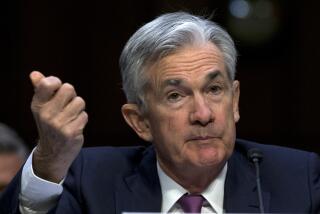If ‘Bubble’ Bursts, Legacy of Greenspan May Deflate
- Share via
As central bankers and prominent economists gather today in Wyoming to assess Alan Greenspan’s 18-year stewardship of the U.S. economy, the Federal Reserve chairman is expected to win widespread plaudits for fostering solid economic growth while deftly managing several financial crises.
But the final chapter of Greenspan’s legacy might be based on how well the central bank manages what many experts say is a crisis looming on the horizon: a housing bubble.
Many experts say the nation’s real estate market draws disturbing similarities to stocks in the late 1990s -- a market driven to unsustainable price levels by what Greenspan famously called “irrational exuberance.” They fear a similar ending: a sharp fall in prices that could bite the net worth of many Americans and trigger a recession.
And some experts say Greenspan deserves at least some of the blame for fostering housing market conditions that the Fed chairman himself has called “frothy.” The Fed, they say, hasn’t done enough to damp real estate speculation, while maintaining cheap credit for too long.
Although Greenspan has warned of the pitfalls of “interest only” loans and other riskier mortgages, the central bank should be doing more to tighten lending standards and discourage their use, these experts say.
“The Fed deserves some criticism for its handling of the stock bubble and now the housing bubble,” says Mark Zandi, chief economist for Economy.com, a research firm in West Chester, Pa. Among other things, Zandi says, Greenspan should be “talking more forcefully” about housing conditions while tightening lending standards.
“The more he waits, the more the bubble inflates, the more risk” of a blowup, Zandi says.
The issue of how the central bank handles any housing bubble is expected to be discussed at the 29th annual Fed conference in Jackson Hole, Wyo. It will be the 79-year-old chairman’s last official appearance at the prestigious two-day gathering before his retirement in January.
The conference, hosted by the Federal Reserve Bank of Kansas City, has become one of the most important forums to discuss key economic issues. And this year’s theme, “The Greenspan Era: Lessons for the Future,” is expected to fuel speculation about who will succeed the second-longest-serving Fed chairman.
Three prominent economists often cited as among the leading contenders are expected to attend the gathering. They are Martin Feldstein, a former Reagan administration economic advisor and now a Harvard University economist; Ben Bernanke, a former Fed official and now chairman of President Bush’s Council of Economic Advisors; and Glenn Hubbard, Bush’s top economic advisor during his first term and now dean of Columbia University’s business school.
Many economists who praise Greenspan’s overall record nonetheless are critical of his handling of the housing market.
“This will have been the most successful period in the history of the Federal Reserve system,” William A. Niskanen, a Reagan administration economic advisor and now chairman of the conservative Cato Institute in Washington, says of Greenspan’s tenure. But, he says, the Fed chief made three major mistakes, including fostering banking regulations that helped precipitate today’s low mortgage rates -- “a condition that has contributed to what now looks like a housing bubble.”
Not everyone agrees that the housing market is a bubble in danger of popping. Housing industry leaders and others say the boom, which has driven up prices by as much as 40% in Southern California and other hot markets in the last two years, is justified by growing population, strong buyer demand and a limited supply of homes. And while double-digit price rises are already slowing in California and elsewhere, thanks in part to the Fed’s interest rate hikes, they are more likely to level off instead of plunge, industry leaders say.
For their part, Greenspan and other Fed officials have said they can’t and shouldn’t target possible bubbles in stocks, housing or other assets, partly because it’s hard to know precisely what constitutes a bubble. Policies aimed at attacking bubbles could produce other unwanted side effects, they have said.
Instead, Fed officials have suggested they would seek to ease the aftermath of any bubbles -- as they did following the 2000 stock crash. Their quick efforts then to cut interest rates, experts say, helped make the 2001 recession relatively mild.
But some economists say the Fed cut rates too far, and kept them low too long. The 2001 recession was primarily caused by a pullback in spending by businesses, not by consumers. Historically low rates, designed to stimulate an economic recovery, encouraged consumers and investors to bid up home prices abnormally high, with signs of speculation emerging as early as 2002, says Edward Leamer, director of the UCLA Anderson Forecast and one of the first economists to label the current housing market a bubble.
“There’s no question that the Fed should have much earlier raised interest rates, not to kill the housing sector, but to keep it sustainable,” Leamer says.
He adds that today’s housing market is different from the dot-com stock mania of the late 1990s, in that soaring Internet stock prices could at least be justified by the perception that technology was changing the world, creating a “new economy.” Greenspan was blamed for helping fuel the stock bubble with statements in the late 1990s touting the “new economy.”
But “houses are exactly the same now as two years ago. There is no ‘new economy’ when it comes to homes,” Leamer says. Thus, cooling off housing should have been “an easy call to make.”
The Fed began raising its benchmark short-term interest rate in June 2004, and has done so 10 times since, in increments of a quarter percentage point each, to the current level of 3.5%.
The Fed’s ideal, economists say, is to engineer a “soft landing” similar to the one in 1994-95. Then, Fed rate hikes cooled off the economy without triggering a recession. The 1990s boom was the longest economic expansion in the postwar period, often cited as one of Greenspan’s crowning achievements.
But soft landings aren’t easy. It’s difficult to deflate a bubble without causing a crash.
Another complication for the Fed chairman: high energy prices. With consumers suffering at the gasoline pump and businesses facing bigger energy bills, raising rates too aggressively could trigger an economic slowdown. All postwar recessions, except the one in 1960, were preceded by energy price surges.
“Today’s extraordinarily low real borrowing costs just might spare the U.S. economy from another energy-related slump,” says John Lonski, chief economist at Moody’s Investors Service in New York.
Another problem that Greenspan faces in managing a possible bubble: The Fed doesn’t control long-term interest rates, which help determine the level of long-term mortgages. Long-term interest rates, such as the yield on 10-year Treasury notes, are influenced by bond market investors, including foreign central banks, pension funds and speculators. They have kept long-term rates relatively low, defying repeated Fed hikes in short-term rates.
“The Fed has been singularly unsuccessful in cooling down the hot U.S. housing market, primarily because its rate hikes have had little impact on long-term interest rates -- so far,” says Nariman Behravesh, chief global economist at Global Insight, an economic consulting firm in Waltham, Mass.
Some economists say that Greenspan’s methods of signaling Fed rate increases -- making them fairly predictable -- have had the unwanted effect of encouraging housing speculation.
“There is not enough uncertainty about Fed rate hikes.... That causes people to take on too much risk,” says Zandi of Economy.com.
Speculators are further encouraged by the Fed’s stance that it won’t target asset bubbles, Zandi says. “The view that policymakers have nothing to say about asset markets is counterproductive.” Fed officials “need to have the courage of their convictions and weigh in.”
Greenspan early last year praised the advantages of adjustable-rate mortgages. The riskiest versions of adjustable-rate mortgages are now widely cited for aggravating a possible bubble by helping people overextend themselves to buy homes they otherwise couldn’t afford.
In any event, the dilemma of the housing market will soon be inherited by Greenspan’s successor. Greenspan became Fed chairman in August 1987 -- two months before the 1987 stock market crash.
More to Read
Inside the business of entertainment
The Wide Shot brings you news, analysis and insights on everything from streaming wars to production — and what it all means for the future.
You may occasionally receive promotional content from the Los Angeles Times.










